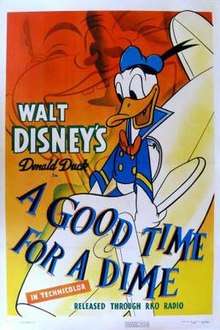A Good Time for a Dime
A Good Time for a Dime is a 1941 Disney short film in which Donald Duck watches a risqué Daisy perform the "Dance of the Seven Veils" in a Mutoscope at a penny arcade nickelodeon peep show.[1] Donald also struggles with a crane drop machine and a miniature airplane ride.
| A Good Time for a Dime | |
|---|---|
 Film Poster | |
| Directed by | Dick Lundy |
| Produced by | Walt Disney |
| Starring | Elvia Allman Pinto Colvig Walt Disney Clarence Nash |
| Music by | Leigh Harline |
| Animation by | J.C. Melendez Ted Bonnicksen Bob Carlson Walt Clinton John Elliotte Jack Gayek Art Fitzpatrick |
| Color process | Technicolor |
Production company | |
| Distributed by | RKO Radio Pictures |
Release date | May 9, 1941 |
Running time | 7 minutes 37 seconds |
| Country | United States |
| Language | English |
Concerning the "somewhat orientalized Daisy", the Encyclopedia of Walt Disney's Animated Characters says that her appearance is "a brief and anonymous one; it is also her sexiest."[2] However, it has been criticized as "unproblematically [representing] all of the Western stereotypes about the harem. A Good Time for a Dime manufactures the harem as a setting separate from any social phenomena and full of obliging women happily catering to male sexual fantasies."[3]
Plot
Inside a penny arcade, Donald inserts a coin to play a Mutoscope entitled "Dance of the Seven Veils". The pictures show dances of a Daisy Duck looking dancer until Donald's viewing is rudely interrupted by a black out. Next Donald tries out a crane machine to win a camera, but he finishes empty handed. Then Donald goes on a coin-operated airplane ride, but his ride is very short. When he tries to get another ride for free, the plane goes out of control, Donald nearly getting caught in the airplane propellers and becoming airsick. With that, Donald leaves the arcade.
Reception
The Film Daily called the short a "dandy cartoon", saying, "Donald Duck is back with a plenitude of hearty laughs for audiences in this short."[4]
Motion Picture Herald said that A Good Time for a Dime is "an excellent Donald Duck color cartoon that pleased everyone,"[5] and "one of Disney's funniest".[6]
References
- Lenburg, Jeff (1999). The Encyclopedia of Animated Cartoons. Checkmark Books. pp. 74–76. ISBN 0-8160-3831-7. Retrieved 6 June 2020.
- Grant, John (1998). Encylopedia of Walt Disney's Animated Characters (2nd ed.). Hyperion. p. 81. ISBN 978-0786863365.
- Smoodin, Eric Loren (1993). Animating Culture: Hollywood Cartoons from the Sound Era. Rutgers University Press. p. 24. ISBN 9780813519494. Retrieved 13 June 2020.
- "Reviews of Short Subjects". The Film Daily. 79 (95): 9. May 15, 1941. Retrieved 13 June 2020.
- "Short Features". Motion Picture Herald. 143 (11): 50. June 14, 1941.
- "Short Features". Motion Picture Herald. 143 (10): 61. June 7, 1941.